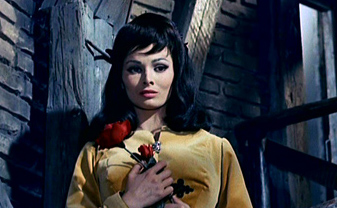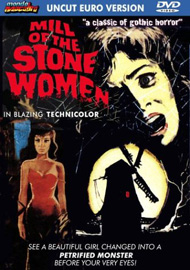| Release List | Reviews | Price Search | Shop | Newsletter | Forum | DVD Giveaways | Blu-Ray/ HD DVD | Advertise |
| Reviews & Columns |
|
Reviews DVD TV on DVD Blu-ray International DVDs Theatrical Reviews by Studio Video Games Features Collector Series DVDs Easter Egg Database Interviews DVD Talk TV DVD Talk Radio Feature Articles Columns Anime Talk DVD Savant HD Talk Horror DVDs Silent DVD
|
DVD Talk Forum |
|
|
| Resources |
|
DVD Price Search Customer Service #'s RCE Info Links |
|
Columns
|
 |
Mill of the Stone Women
|
||||
1960 was a boom year for international horror. From America came the first of the Corman-Poe pictures and Psycho; in England Hammer was running strong and Michael Powell brought out (briefly) Peeping Tom. On the continent Mario Bava's Black Sunday made its influential debut, and Roger Vadim released his bizarre Carmilla story Et Mourir de Plaisir (Blood and Roses). An exotic runner-up among these attractions was Giorgio Ferroni's Mill of the Stone Women, a shocker that made a successful European run. It didn't show in the United States for three years. The UK outfit Mondo Macabro has been releasing Region 1 DVDs for a while now. This deluxe presentation of Mill of the Stone Women rejuvenates a classic title that, at least in the U.S., had existed only as a rumor. All we ever seemed to see were faded, flat VHS transfers of a cut-up and badly dubbed version. Of the people I knew who had actually seen it, none could remember it clearly except to say that the original Technicolor was stunning.
Mill of the Stone Women is an artfully contrived horror concoction clearly inspired by the previous year's Eyes Without a Face. While Italians Bava, Margheriti and Freda were making underfunded B&W films, Giorgio Ferroni got to work with color, beautiful sets and elaborate art direction. This mad doctor hybrid rethinks a fairytale-like story about a moritiferous young woman in a setting reminiscent of The Mystery of the Wax Museum. Hans arrives in a moody Flemish canal town and finds trouble in Dr. Wahl's creepy windmill-house where the rooms are strewn with art bric-a-brac and odd statuary. A local tourist attraction is rigged to the windmill's clockwork, a carillon display of female mannequins that parade on a track to the amusement of visitors. They represent ill-fated females from history: Joan of Arc, Cleopatra, etc. One is a graphic hanging victim and another lies ready at the head-chopping block. But the weirdest woman in the mill is an elusive pianist who first appears holding a dog on a leash, just as did Barbara Steele in Black Sunday. Beautiful but strange, Elfi is that woman whose attraction hides secrets we'd rather not know about, the one who appears in stories from the Bible onward to inspire men to foolish decisions. Hans is honest but vulnerable and gives in to Elfi's enticements. 1 The next day Hans has learned the difference between lust and love and guiltily declares himself to pert Liselotte. But Elfi overhears them. Although professor Wahl entreats Hans to stay away from Elfi - her health is very precarious - Hans meets with her to break off the affair with honor. Elfi appears to die on the spot from some kind of seizure. After wandering the night in a disoriented state, Hans returns to the mill and the sinister Dr. Bolem gives him a "tranquilizer." Hans proceeds to hallucinate a number of strange phenomena - missing pendants, bloody knives, a redheaded beauty bound and gagged in the doctor's basement laboratory. He briefly sees Elfi both alive and dead in a cobweb-filled room. It's at this point that Mill of the Stone Women drops its supernatural tone to become a medical horror picture. Professor Wahl and Doctor Bolem's morbid secret requires the blood of young women and the thriller resolves with a kidnapped heroine and a last-minute rescue. But there are decidedly macabre touches. Corpses are fashioned into statues, a dummy is buried in place of a body. All of this would be exploitation trash if it were not for director Ferroni's well-developed morbid aesthetics. The basic "save one woman by exsanguinating another" idea had been done to death in films like She Demons and only in the previous year's Eyes Without a Face was it suggested that such trashy pulp could become surreal art. Mill of the Stone Women sets a fantastic stage with the strange architecture of the Mill interior and the carillon. Expressive lighting creates images that animate and elevate the drama. There's nothing crude about the delicate use of color to support the performances. Professor Wahl's entrance through a narrow aisle of carved emblems and religious sculptures gains depth and drama with its rich lighting scheme that includes a blood-red patch of light on the floor. Elfi stands holding a crimson rose (much like Annette Stroyberg in Blood and Roses) or lies draped across her bed awaiting the arrival of Hans, bathed in chroma contrasts that heighten her sensuality. In a two-shot embracing Hans, she moves from rimlit backlight to a careful composition with a Joan Crawford-like eyelight across her otherwise dark face. This is more than just pretty pictures, it's the kind of extraordinarily careful lighting seldom seen in genre efforts. The "aesthetic delirium" has an impact similar to that of Vertigo. In horror, only Freda's The Horrible Dr. Hichcock and Bava's Black Sabbath have a more compelling color atmosphere. Mill of the Stone Women takes place sometime around 1912 and has a good sense of period decor. The canal-side exteriors are hazy and overcast. To get to the mill, one uses a bell like the one in Dreyer's Vampyr. It's been pointed out that many of the set dressings are familiar from other Italian horror films, so it's likely that the Belgian exteriors were all matched to interiors shot in Rome. The only production disappointment is the unconvincing miniature of the mill used for night exteriors - it weakens the film's ending. The musical score veers from a creepy carillon tune to a lush romantic theme for Elfi's seductions. The acting is all fairly formalized. The two mad doctors behave in an expressionist manner, one obsessed with saving his daughter and the other obsessed with bedding her. They're both gentlemen scholars who function as kidnappers, murderers and mutilators of young women, and that doesn't take into account the bizarre regimen of transfusions they're putting Elfi through. Herbert Boehme is intimidating as the father. Sinister Wolfgang Preiss (The 1,000 Eyes of Dr. Mabuse) mixes his surgical villainy with an understandable lust for the heroine. 
Scilla Gabel is the film's focus. Pete Tombs explains her appeal - the ravishing Italian beauty served as Sophia Loren's stand-in before using plastic surgery to find her own look (shades of Lex Yeux sans Visage!). Her full body contrasts with a face that's all bone structure - her skin appears to be stretched across her cheeks far tighter than Barbara Steele's. She's a lean vixen with hungry, haunted eyes. Between Gabel, Steele and Dahlia Lavi (The Whip and the Body) we get a full spectrum of exotic horror heroines. Our hero Pierre Brice is handsome enough (Tombs tells us he played Winnetou the Indian in a series of German Westerns) and gives Hans some needed complexity. He can't resist Elfi's invitation and feels he's betrayed both her and Liselotte. 2 Hans looks suitably frazzled when given Dr. Bolen's tranquilizer - what is it, LSD? - and outraged when he discovers the full depth of the plot. The biggest name in the picture is Dany Carrel, a sexy contender for stardom with an interesting face. She's mostly decoration here, providing the slight bit of nudity that puts the film on the transgressive edge where it needs to be. Marco Gugliemi serves as the gee-whiz best friend. Liana Orfei is the beautiful victim to fulfill the Eyes Without a Face formula quoted by Raymond Durgnat - one girl is sacrificed, and another saved in the nick of time. Foolish Professor Wahl forgets Rule Number One when dealing with a madman: Allow the genius surgeon to revive your daughter before you stab him to death. Although the mad doctor machinations provide a fiery ending what we remember most from Mill is our hero's seduction by a strange woman who asks him to throw caution and responsibility to the wind. The doom she represents is difficult to separate from society's double standard that encourages young men to take what they can get while they can get it. Elfi is neither vampire nor madwoman, but she is a prejudiced image of the female sex, an example of the "mysterious female" representing the notion that Sex is evil in itself. She's a Lorelei, a Siren, the woman with the skull face representing lust or vanity in all the old engravings, the one that symbolized War in old political cartoons. Mill of the Stone Women is an excellent example of an undefined misogynistic myth. Mondo Macabro USA's NTSC DVD of Mill of the Stone Women is a stunning presentation. I've watched terrible brown VHS cassettes trying to imagine a good copy, and this disc is it. The enhanced image is obviously from a good 35mm element and the transfer is basically fine. The color is rich and overall sharpness is good. The discmakers appear to have had access to a full complement of excellent material. The film comes with three audio tracks - the dub for the U.S. version supervised by Hugo Grimaldi (the import film molester known for Gigantis the Fire Monster and First Spaceship on Venus), a UK dub, and the French dub. I recommend watching the French dub with English subtitles - the voices are much harsher in English, and the lip movement seems to match the French dialogue better, except for Liana Orfei's pub song. Her lips clearly match the German lyrics heard in the trailer. The version differences are rather confusing. In the feature, the French audio reverts to English for a couple of short scenes apparently trimmed from the French cut. Three other deletions are presented separately. In one scene Dany Carrel watches a puppet show on a bridge. An alternate version of Hans' drug hallucination is there, along with an elegant title sequence for the French release, Le moulin des supplices (Mill of Tortures). I wish the disc had used this instead of Grimaldi's ugly English replacement. His main title treatment would be more suitable for The Flintstones. Mondo Macabro loads the galleries with extras. There's an American trailer and a full set of promotional posters and pressbooks from all the international markets. Long and detailed bios for several of the actors are included, but not for the director. The entries for Scilla Gabel (we're told to pronounce it Shee-la) and Dany Carrel come complete with racy nude photos, quite a surprise. An entry on the film itself features extensive facts and observations compiled by noted Eurohorror critic Pete Tombs.
On a scale of Excellent, Good, Fair, and Poor,
Mill of the Stone Women rates:
Footnotes:
1. An unusual variation on
this theme is in Stephen Sondheim's musical
Passion.
2. That's not a line I recommend using on a girlfriend: "I slept with
her but it's okay because in the process I discovered I love you. Forgive me?"
Review Staff | About DVD Talk | Newsletter Subscribe | Join DVD Talk Forum |
|
| Release List | Reviews | Price Search | Shop | SUBSCRIBE | Forum | DVD Giveaways | Blu-Ray/ HD DVD | Advertise |






